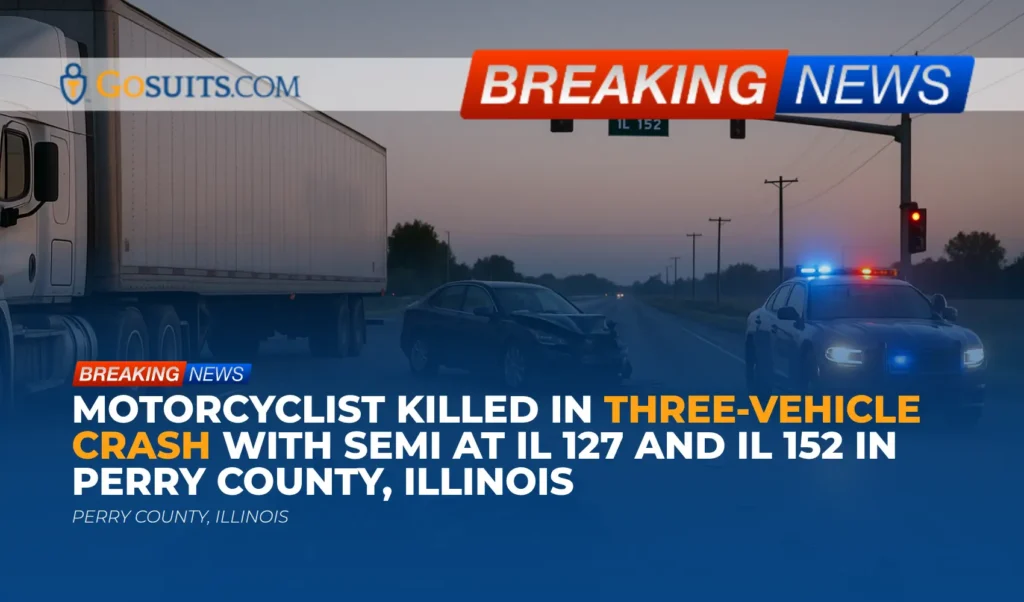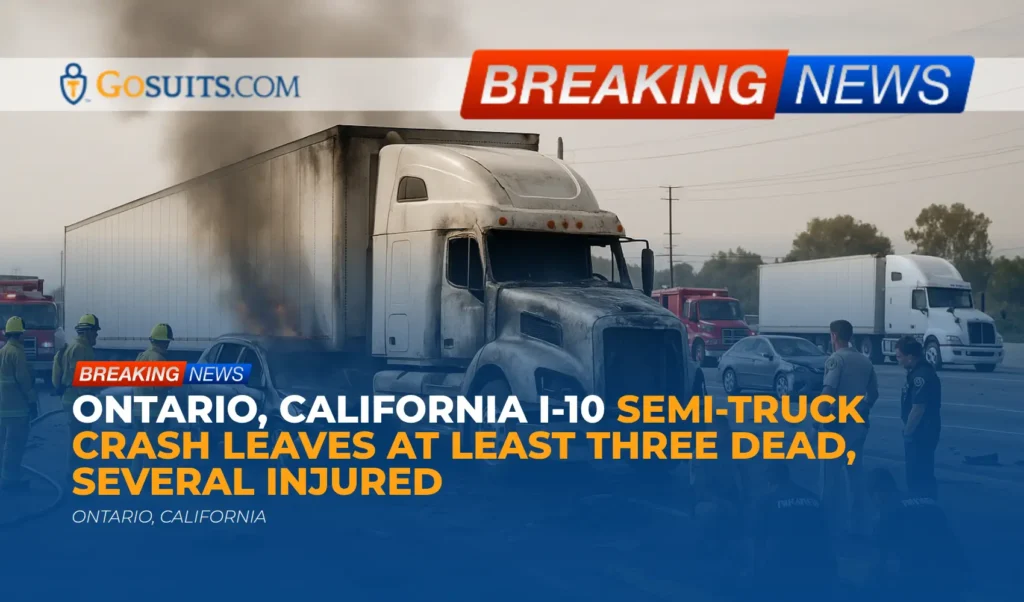- What we know about the Westfield crash
- Where and when it happened
- Agencies involved and current status of the investigation
- Head-on collisions: context, risk, and prevention
- Legal rights of injured people and families after a fatal crash in Illinois
- Potential civil liability considerations
- Insurance coverage issues that often arise in Illinois crashes
- Important first steps to protect claims and preserve evidence
- How to obtain official records (police report, coroner and autopsy information, medical and death records)
- How crash investigations typically proceed and what evidence may matter
- Community safety considerations near West Lincoln Street and South Division Street
- Commentary from Gosuits Westfield, Illinois Personal Injury Attorney
- Why timely action matters now
What we know about the Westfield crash
A tragic two-vehicle head-on collision in Westfield, Illinois left two people dead at the scene and two others hospitalized. Illinois State Police stated that a vehicle traveling east on West Lincoln Street crossed the center line and struck a westbound vehicle head-on. First responders closed the roadway for several hours, reopening close to 1 a.m., while investigators documented the scene. As of the most recent public updates, the crash remains under investigation. Names, ages, and additional identities had not been released at the time of reporting.
When a head-on crash occurs because one vehicle crosses the center line, investigators typically consider a range of potential contributing factors, including distraction, impairment, fatigue, speeding, mechanical issues, sudden medical emergencies, or evasive maneuvers to avoid another hazard. At this time, officials have not announced a definitive cause, and it is important to avoid speculation until the investigation is complete.
Where and when it happened
The collision occurred just after 7 p.m. on a Friday evening on West Lincoln Street near South Division Street in Westfield, Illinois. Evening crashes can present unique visibility and traffic challenges, particularly as daylight fades. The reported location is within a community area where local traffic includes residents returning home, visitors, and service vehicles.
Time-of-day, lighting, and roadway configuration can be relevant to how a crash unfolds. Investigators typically review lighting conditions, lane markings, posted speed limits, available signage, and sightlines at the location, as well as whether there were any temporary obstructions or construction activities nearby.
Agencies involved and current status of the investigation
The Illinois State Police responded and are conducting the crash investigation. In fatal or serious-injury crashes, ISP commonly documents the scene with measurements, photographs, and diagrams; identifies and interviews witnesses; examines vehicles; and requests any available camera footage (public or private). When fatalities occur, the county coroner’s office is also typically involved to determine and certify the cause and manner of death and to oversee any autopsy and related findings.
At this stage, officials have said the investigation is ongoing. It is normal for a final report to take weeks, and sometimes longer, especially if toxicology tests, mechanical inspections, or crash reconstruction analyses are involved.
Head-on collisions: context, risk, and prevention
Head-on collisions are among the most dangerous roadway events because closing speeds are high and forces on occupants are severe. National data consistently show that frontal impacts account for a substantial portion of roadway fatalities. The U.S. Department of Transportation and the Federal Highway Administration promote countermeasures such as center line rumble strips, enhanced pavement markings, and improved signage to reduce centerline cross-over crashes. See FHWA’s roadway departure safety resources for more on these measures: FHWA Rumble Strips and Safety.
Illinois publishes statewide crash facts and data through its transportation agency. For historical and contextual crash information, including trends and factors, the Illinois Department of Transportation provides a public crash data portal: IDOT Crash Data. While those statewide resources cannot assign fault in any individual crash, they help illustrate the patterns and risks associated with head-on collisions and the importance of roadway design and enforcement strategies aimed at reducing centerline departures.
Legal rights of injured people and families after a fatal crash in Illinois
Families who lose a loved one in a crash and people who survive with injuries often face medical bills, funeral expenses, lost income, and profound grief. Illinois law provides civil avenues to seek accountability and financial recovery from at-fault parties. These claims are separate from any criminal process and focus on the harms and losses experienced by victims and their families.
Key Illinois statutes include:
- Wrongful Death Act: Allows the personal representative of the decedent to bring a claim for the benefit of surviving next of kin for losses such as grief, sorrow, and loss of support, among others. See 740 ILCS 180 (notably Section 2).
- Survival Act: Preserves the decedent’s own claims that existed before death, such as conscious pain and suffering, medical bills, and property damage. See 755 ILCS 5/27-6.
- Statutes of limitations: Personal injury claims typically must be filed within two years. See 735 ILCS 5/13-202. Wrongful death claims generally must be brought within two years of death, subject to specific statutory rules. See 740 ILCS 180/2. Different or shorter deadlines may apply in certain circumstances (for example, claims involving public entities may face a one-year limitation under 745 ILCS 10/8-101).
Illinois follows a modified comparative negligence system. A claimant’s recovery is reduced by their percentage of fault, and recovery is barred if the claimant’s fault is greater than 50 percent. See 735 ILCS 5/2-1116. In the context of a centerline crossing, liability analysis may consider roadway position, speed, impairment, distraction, and other factors, but final conclusions depend on the completed investigation.
Potential civil liability considerations
When a vehicle crosses a center line and causes a head-on crash, investigators and insurers closely evaluate whether established safety rules were violated. Illinois traffic law generally requires motorists to drive on the right half of the roadway, with limited exceptions. See 625 ILCS 5/11-701. Breaching such rules can support a finding of negligence if the violation contributed to the crash. Still, civil liability is ultimately assessed after considering all evidence, including any valid legal exceptions or sudden emergencies.
Additional factors commonly considered include:
- Driver condition: Fatigue, distraction, or impairment can shift lanes or delay reaction time. Toxicology and phone records are sometimes reviewed as part of an investigation.
- Speed and stopping distance: Even modest speed changes can materially affect stopping distances and crash severity.
- Vehicle condition: Sudden mechanical failures (e.g., tire blowouts, steering defects) are uncommon but can be material; this is assessed through vehicle inspections and, when available, onboard data.
- Roadway environment: Lane markings, signage, lighting, and recent maintenance can inform whether visibility and guidance were adequate.
- Third-party responsibility: In some cases, parties beyond the drivers may bear partial responsibility, such as entities responsible for roadway maintenance or, in rare cases, others who created a hazard that led to an evasive maneuver. The facts determine whether any such theories are viable.
It is also possible for multiple individuals or entities to share responsibility. Illinois’ comparative negligence framework apportions fault among responsible parties, which can affect the allocation of damages. See 735 ILCS 5/2-1116.
Insurance coverage issues that often arise in Illinois crashes
Illinois is an at-fault insurance state. The driver who is found to have caused a crash is generally responsible for damages through their liability insurance. Illinois law requires drivers to carry minimum liability coverage and uninsured motorist (UM) coverage; underinsured motorist (UIM) coverage is also required in certain circumstances. See the Illinois Secretary of State’s overview of mandatory insurance requirements at ilsos.gov and additional consumer guidance from the Illinois Department of Insurance at insurance.illinois.gov.
Coverage issues that frequently come up in severe and fatal crashes include:
- Policy limits: Serious injuries and wrongful death claims often exceed the at-fault driver’s liability limits. UM and UIM may provide additional protection when the at-fault driver has no insurance or insufficient limits.
- Stacking and coordination: Whether policies can be combined and how different coverages interact depends on policy language and Illinois law.
- Household and resident relative coverage: Policies for family members in the same household can sometimes provide additional benefits.
- Medical payments (MedPay): Optional coverage that can help with immediate medical costs, regardless of fault, subject to policy terms.
Before initiating any recorded statement or claim with an insurance company, it is prudent to consult with a qualified attorney. What is said to insurers can be used later to limit or deny claims, and early guidance helps protect rights and avoid missteps.
Important first steps to protect claims and preserve evidence
The period immediately after a severe crash can feel overwhelming. Still, timely action preserves evidence and helps ensure that the full story is documented. The following steps are general, practical measures that are often helpful:
- Request the police crash report: Illinois State Police make crash reports available through an online portal. When the report becomes available, it can be requested here: ISP Crash Reports. If the report is not yet released, note your report number (if known) and check back periodically.
- Document injuries, treatment, and expenses: Maintain records of hospital visits, imaging, prescriptions, and out-of-pocket costs. These records help verify damages and needed follow-up care.
- Identify and preserve evidence: Save photos of the scene and vehicles; list potential witnesses; note nearby cameras (residences, businesses, traffic cameras) that might have captured the crash. Video can be overwritten quickly, so requests should be made promptly.
- Secure vehicle storage: If possible, avoid authorizing premature disposal or repair of vehicles until an inspection and documentation are complete. Vehicles can contain critical physical evidence and onboard data.
- Avoid statements to insurers without guidance: Insurance adjusters often contact people quickly. Consider consulting an attorney first; statements can be used later and may impact claim outcomes.
- Track work and income impacts: Keep a log of missed work, lost income, and any job-related limitations due to injuries or bereavement.
How to obtain official records (police report, coroner and autopsy information, medical and death records)
Timely access to official documents helps families understand what happened and supports any potential civil claims. Here are the sources most commonly involved after a fatal or serious-injury crash in Illinois:

Police crash report
Illinois State Police post reports for purchase through their public portal when they are ready. You can monitor for and request the report here: Illinois State Police Crash Reports. The report number, date of crash, and involved names (if known) can aid the search. Supplemental documents, such as diagrams or reconstruction summaries, may be issued separately and can sometimes be requested later if they exist and are releasable.
Coroner and autopsy information
In fatal crashes, the county coroner is responsible for determining cause and manner of death and for arranging any autopsy and toxicology. For a death in Westfield, contact the coroner in the county with jurisdiction over the place of death. The coroner’s office can explain which records can be released to next of kin and when they become available. If you are unsure of jurisdiction, the Illinois State Police or the local sheriff’s office can typically confirm which coroner handled the case.
Coroner records and autopsy reports are governed by Illinois law and may be subject to confidentiality or delayed release depending on the status of the investigation. When requesting records, be prepared to provide proof of relationship if you are next of kin.
Death certificate
Certified death certificates are typically obtained through the county clerk in the county where the death occurred, with statewide guidance available from the Illinois Department of Public Health. See: IDPH Vital Records. Death certificates are often needed to settle estates, access benefits, and support insurance claims.
Medical records
Hospitals and clinics maintain treatment records for injured patients. Under federal law, patients (or authorized representatives) have a right to access medical records, subject to reasonable procedures and fees. See the U.S. Department of Health and Human Services guidance: HHS: Your Right to Access Health Records. For a deceased person, a legally authorized representative or estate representative may request records.
Crash data and statewide statistics
For broader context (not a substitute for the official crash report), statewide crash data are published by the Illinois Department of Transportation: IDOT Crash Data. These resources help illustrate patterns and risks but do not determine fault in individual cases.
How crash investigations typically proceed and what evidence may matter
Fatal and severe-injury crash investigations involve several layers of analysis. Understanding the process can help families anticipate timelines and the types of information that may eventually be available:
- Scene documentation: Investigators record final rest positions, skid and yaw marks, debris fields, and line-of-sight conditions. Measurements and photographs are used to reconstruct pre-impact paths and speeds.
- Vehicle inspections: Damage profiles, restraint use, airbag deployment, and mechanical conditions are examined. If there is any suggestion of a mechanical issue, more detailed inspections may be performed.
- Event Data Recorder (EDR): Many modern vehicles store limited pre-crash data such as speed, brake application, and throttle. Access depends on the vehicle and equipment; see NHTSA’s overview of EDRs here: NHTSA: Event Data Recorder.
- Witness statements and video: Independent eyewitnesses and camera footage can corroborate timelines and lane positions, especially in head-on scenarios.
- Toxicology and medical findings: In fatal cases, the coroner manages toxicology. For injured drivers, medical records may help clarify whether a sudden health event played a role.
Once official findings are released, they can inform civil claims analysis, including liability allocation and insurance coverage evaluation. It is common for professionals to supplement the official investigation with independent expert reviews when necessary.
Community safety considerations near West Lincoln Street and South Division Street
When a centerline crossing results in a head-on collision, communities often look closely at the roadway and surrounding environment. While individual driver behavior is critical, roadway design and maintenance can support safer outcomes. Measures that agencies commonly evaluate include reflective centerline markings, center line rumble strips, speed management, improved lighting, and targeted enforcement during higher-risk times of day. FHWA identifies rumble strips and enhanced markings as proven strategies to reduce roadway departure crashes: FHWA Rumble Strips and Safety.
Residents who live or travel near West Lincoln Street and South Division Street may consider sharing observations with local authorities about visibility, signage, or recurring near-misses. Practical community feedback can help transportation authorities prioritize countermeasures that fit local conditions.

Commentary from Gosuits Westfield, Illinois Personal Injury Attorney
Our hearts go out to everyone affected by this devastating crash near West Lincoln Street and South Division Street. Losing community members and seeing others hospitalized is profoundly difficult, and we extend our sincere condolences and hopes for healing. This discussion is offered for general educational purposes to help community members understand common legal and practical issues that arise after serious roadway incidents.
Based on the public information, the reported centerline crossing and head-on impact raise serious questions about driver responsibility under Illinois traffic laws that require vehicles to remain on the right half of the roadway with limited exceptions. See 625 ILCS 5/11-701. Still, it is important to wait for a complete investigation, which may evaluate factors like speed, distraction, impairment, or sudden emergencies, and to understand whether any vehicle or environmental conditions played a role.
In our experience, large insurance companies move quickly to control the narrative, collect statements, and minimize payouts. Adjusters may ask for recorded statements or medical authorizations early. These requests can seem routine, but what is said or signed can be used later to dispute fault or reduce claim value. Corporations and insurers handle claims every day; people impacted by a sudden tragedy typically do not. That information imbalance often shapes outcomes unless those affected receive guidance about their rights and the types of documentation that matter.
A no-cost initial consultation can help people understand options, potential insurance coverages (including UM/UIM and MedPay), and deadlines under Illinois law, such as those in the Wrongful Death Act and the general two-year limitation for personal injury claims in 735 ILCS 5/13-202. It can also help ensure that critical evidence like EDR data, vehicle inspections, and nearby video footage is preserved before it disappears.
Why timely action matters now
Taking clear, prompt steps after a severe or fatal crash can make a meaningful difference in clarity and outcomes:
- Clarify facts early: Witness memories fade quickly, and many security systems overwrite video within days. Early outreach to identify and save footage can secure objective evidence of lane positions, speeds, and signals.
- Protect legal timelines: Illinois law sets firm deadlines for civil claims, with different timelines that may apply depending on the parties involved. Acting early allows for proper investigation and avoids last-minute, incomplete filings.
- Preserve vehicles and data: Vehicles may be moved, repaired, or salvaged before anyone downloads EDR data or inspects critical components. Proactive preservation action keeps the best evidence intact.
- Coordinate medical documentation: Hospitals and clinics can provide detailed records, but it takes time. Requesting records early supports accurate assessments of injuries and losses.
- Navigate insurance carefully: Insurance representatives may request statements and forms rapidly. Before engaging, consult an attorney to understand obligations and risks. Statements can be used to reduce or deny claims later.
For official documents, monitor the availability of the Illinois State Police crash report at isp.illinois.gov/CrashReports. For certified death records, follow guidance from the Illinois Department of Public Health at dph.illinois.gov. For questions about mandatory insurance and coverage options in Illinois, the Illinois Secretary of State and the Department of Insurance publish helpful information at ilsos.gov and insurance.illinois.gov.
Staying organized, requesting the right records, and seeking knowledgeable guidance early helps ensure that the investigation is thorough and that rights are preserved while facts are still fresh.






